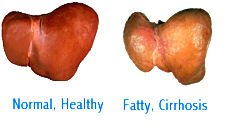Cirrhosis is the chronic disease of the liver, marked by dense periolobular connective
tissue, degenerative changes in parenchymal cells, structural alteration of the cords of
the liver lobules, fatty and cellular infiltration, and often, development of areas of
regeneration. This includes, as well, loss of liver function and increased resistance to
blood flow through the liver. Cirrhosis can lead to ammonia toxicity. There are many
causes of cirrhosis, the most familiar being alcoholism. It can also be caused by passive
congestion of the liver from heart failure called cardiac cirrhosis; infantile, occurring
in children as a result of protein malnutrition; metabolic, resulting from metabolic
disease such as hemochromatosis; and toxic, caused by toxic substance poisoning like
carbon tetrachloride. These are just a few of the causes. Cirrhosis is characterized by
anorexia, chronic dyspepsia, indigestion, nausea and vomiting, constipation or diarrhea,
and dull aching abdominal pain. Many other symptoms may be present as well.
Helpful Links:
Cirrhosis
he liver is the largest organ
in the body. In the healthy adult, it weighs approximately three pounds and is wedge-shaped.
Located immediately below the diaphragm, the liver occupies the entire upper right section
of the abdomen. Cirrhosis of the liver is known to cause scarring, or fibrosis, the main
damage to the liver. This occurs due to excessive alcohol use, viruses, or other causes.
In response to the scarring, liver cells regenerate in abnormal clumps and form nodules
around the scarred areas, acting like dams and altering the flow of blood and bile through
the liver. This causes the spleen to overproduce nitric oxide, and small blood vessels and
bile ducts in the liver itself to constrict. Bile builds up in the blood stream, resulting
in high levels of bilirubin, which causes jaundice. It also causes swelling in the arms and
legs. The liver enlarges early on in the disease, but later, often shrinks. There are
alternative ways to protect the liver, including the use of
Dandelion. The flowers of
Dandelion are rich in lecithin, a liver protector.
Echinacea is an excellent
source of cichoric acid which studies show slows reproduction of viruses, and is helpful
in liver-digestion. Turmeric
and Scullcap are also
known to protect the liver and aid against viruses attacking it.
 These
products are available from our
Virtual Store.
Our liberal
Money Back Guarantee applies.
These
products are available from our
Virtual Store.
Our liberal
Money Back Guarantee applies.